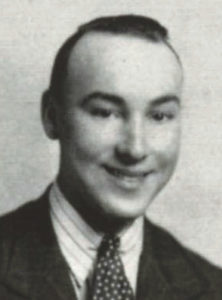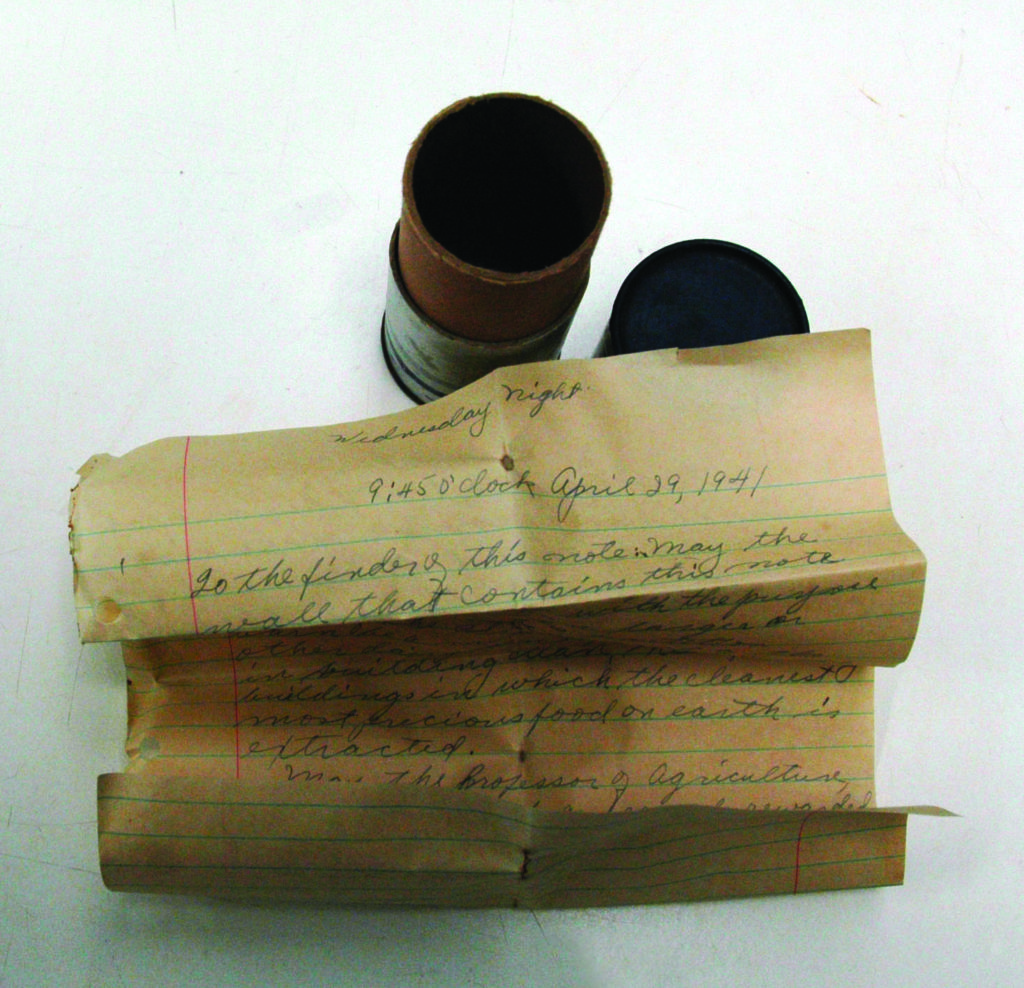Milkhand’s Letter Uncovered in MGCCC Dairy Barn More than 72 years later

Murphy as a freshman at MGCCC
At 9:45 p.m. on April 29, 1941, Perkinston Junior College student Charles Earl “C.E.” Murphy wrote a letter. He placed the letter in a canister and inserted it into a wall of the concrete-block Dairy Barn, which was completed that same year. Seventy-two years later, on December 6, 2013, a construction worker found the canister during renovation of the Dairy Barn. He promptly delivered the canister to Jason Breland, MGCCC construction manager, who then turned it over to the MGCCC Archives.
In the three-quarters of a century since, the Dairy Barn had changed its use many times. The small concrete block dairy barn was built in 1941 to sell surplus milk to soldiers at Camp Shelby. Construction continued in January 1953 to include a Malvern tile storeroom and pasteurizing plant. Milk processing ceased operation in 1959. The building was then converted into an agriculture classroom. In late 1968, it became the headquarters for the MGCCC Maintenance Department, and in 2000, the building served as the Engineering Building, Computer Service Center and a storage facility. In 2013, plans were made for the Yellow Brick Project. In its next incarnation as part of that project, the Dairy Barn will be utilized to promote a creative economy through community arts-based projects and programming. It will provide a place for students of all ages to experience the arts through classes, performances, exhibits, and workshops that promote creativity and celebrate the community. The project is scheduled for completion in April 2014.
“It is an exciting moment for the college that this letter was found as the Dairy Barn is reanimated and renovated into a community-arts facility,” Dr. Mary S. Graham said. “I think Mr. Murphy would be proud of what the barn will become, even though our expansions are not related to its original purpose as a dairy.”
Murphy, a Vancleave native who died on January 19, 2013, entered Perkinston Junior College on September 10, 1940, and graduated with special honors on June 1, 1942. He was “a milkhand” at Perk, and he was obviously proud of his professor and the then brand-new barn. It was a promising time at Perkinston, but for the world, there was darkness on the horizon in the form of World War II.
Charles Sullivan, MGCCC archivist, has investigated the letter, its author and has proudly added the letter to the archival history of the college.
“Murphy did not know how prophetic his reference to Germany (in the letter) would be,” Sullivan said. “He was on one of 5,000 ships that took part in the greatest amphibious assault in history: D-Day, June 6, 1944.” Murphy’s son, Kenneth, told Sullivan that his father was a machine gunner. He was the recipient of a Purple Heart and an oak leaf cluster, which indicates “twice wounded.”
After the war, Murphy graduated from Mississippi State University with a degree in entomology and retired from the Louisiana State Department of Agriculture with 30 years of service.
Transcript of The Milkhand’s Letter

The letter and the canister in which it was found, December 6, 2013
“To the finder of this note: May the wall that contains this note be destructed only with the purpose of building the barn larger or getting rid of the partition altogether for a betterment of the plan of the structure. May this barn be a model structure for other dairymen to follow suit in building clean, neat, sanitary buildings in which the cleanest most precious food on earth is extracted.
May the Professor of Agriculture, Mr. F. O. Parsons, be generously rewarded (by profits and a wonderful exhibition of his skill as an able and efficient manager) for the tireless efforts that he has put forth in the construction of this modern building.
I hope that when there is reason for this note to be discovered that Mr. Parsons will be retired from active service, that this school will have become a Senior College, that I may be a prominent citizen of the United States and that Germany will have ceased to exist as a distrustful nation.”
A Milkhand—1940-41
C. E. Murphy
For more information about the Yellow Brick Project, contact Sandra Cassibry at (601) 928-6298 or sandry.cassibry@mgccc.edu. The milkhand’s letter can be seen on display in the college archives on the Perkinston Campus, along with other items of interest related to both the college and the Dairy Barn.
